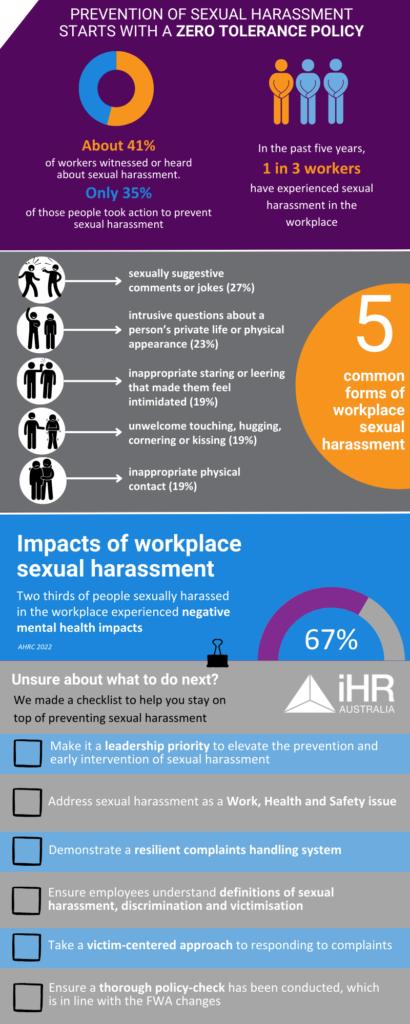Power disparity is known to be one of the key drivers of workplace sexual harassment.

Author: Paula Bruce, Facilitator/Senior Workplace Relations Adviser
The Australian Human Rights Commission (AHRC) Inquiry 2020 found sexual harassment to be pervasive in Australian workplaces. The AHRC Inquiry found sexual harassment impacts as many as one in three workers, and of those affected, 18% do not report the incidents to their managers.
On 28 November 2022, the Anti-Discrimination and Human Rights Legislation (Respect@Work) Bill introduced a positive duty on managers to ensure preventative measures are in place to eliminate discrimination, workplace sexual harassment and victimisation in the workplace.
Importantly, sexual harassment is a persistent social problem driven by gender inequality and often exacerbated for certain groups. Preventing sexual harassment and discrimination starts with an understanding that it is preventable.
We asked Paula Bruce, Workplace Dispute Resolution expert at iHR Australia to help zero in on the recent changes that requires employers to shift their focus to actively prevent workplace sexual harassment and discrimination.
Behaviours and Attitudes that Normalise Workplace Sexual Harassment
The AHRC Inquiry found the two most reported types of behaviour were sexually suggestive comments or jokes and intrusive questions/remarks about a person’s private life or their physical appearance.
Even scenarios where a person is exposed to or witnesses sexually suggestive conduct such as overhearing inappropriate conversations between co-workers can be deemed as sexual harassment in the workplace, according to Fair Work.
To ‘sexually harass’ has the same meaning in S12 of the Fair Work Act and S28A of the Anti-Discrimination Act. That is, a person sexually harasses another person if:
- They make unwelcome sexual advances or an unwelcome request for sexual favours to the person harassed, or
- They engage in other unwelcome conduct of a sexual nature in relation to the person harassed.
Sexual harassment is prohibited where it occurs during or ‘in connection’ with one of the persons being a worker, a person conducting a business or undertaking (PCBU) work or functions in relation to work such as a Christmas or a New Year’s party.
The phrase ‘in connection with work’ at Part 3 5A Fair Work Legislation Amendment (Secure Jobs, Better Pay) Act 2022 is not legally defined but carries significance in the workplace. The action does not have to occur in the workplace but refers to a relationship formed in connection with work.
Common indicators of Sexual Harassment in workplaces
Gender inequality, or power disparity is identified to be one of the key drivers of workplace sexual harassment, amongst other factors like trivialising the behaviour and male peer relations that perpetuates a culture of disrespect towards women.
Other systemic factors that contributed to the prevalence of workplace sexual harassment were found to be:
- The culture of a workplace, including the leadership style and acceptance of unlawful behaviour such as banter, jokes and collusion
- A lack of understanding of what constitutes as sexual harassment
- Use of alcohol
- Victim-blaming
- Organisations that enforce a rigid complaints management process, requiring a formal complaint to be made
How recommendations have been made to shift to positive duty on leaders in the workplace?
The Respect at Work Bill 2022 implements 7 of the 55 recommendations from the AHRC Respect@Work Report. It is a recognition of a right to safety at work.
The legislation imposes on employers a positive duty to take reasonable and proportionate measures to eliminate sex discrimination, harassment, and victimisation and to eliminate or manage associated hazards and risks to a worker’s health, which includes psychological safety.
Workplaces are required to make a shift from a reactive approach in responding to workplace sexual harassment to an obligation to conduct assessments by reference to structural and cultural drivers and then take the positive steps to demonstrate the implementation of a plan.
The assessment of risk needs to be ‘reasonable’, which means considering the size of the organisation, nature of business, resources, business and operational priorities, cost and other relevant factors. The review process may include culture reviews, changes to personnel, rostering and supervision arrangements, and targeted learning and development such as leadership training or a special training on anti-bullying, harassment and sexual harassment in the workplace.
Unless employers can demonstrate that they have taken “reasonable and proportionate” measures, they may be held vicariously liable for the sexual harassment behaviour of their employees.
Employees have the right to apply to the Fair Work Commission for orders to stop sexual harassment in the workplace from continuing, and to deal with disputes (which may also be referred to the courts).

Who can make a difference in relation to workplace harassment?
Having stringent policies and regulations around harassment prevention is critical but the duty does not end there, and organisations need to explore ways to ensure the victim feels safe enough to report incidents.
Organisations should undertake an appropriate form of risk assessment to gain knowledge about how psychosocial factors are experienced in different groups. There is a need to act in a way that is reasonable and proportionate to the issues identified to eliminate the risk.
Employees should be encouraged and required to make reports in a safe and reliable complaints system. Transparent complaints handling processes that provide appropriate confidentiality can help vulnerable employees to report incidents, and gain knowledge and support on how to reach best outcomes.
Greater action at the leadership is imperative in reducing the incidence and impact of sexual harassment at an individual level.
For organisations looking to develop a workplace sexual harassment prevention model, here are six minimum standards to comply with:
- Knowledge
- Prevention Plan
- Organisational capacity
- Risk Management
- Reporting and response
- Monitoring and evaluation
Based on these standards, organisations can develop and implement a highly structured, multi-pronged model that focuses on:
- Elevate the prevention and early intervention on sexual harassment as a leadership priority
- Address sexual harassment as a Work, Health and Safety issue with a focus on safety as a workplace right
- Introduce new principles on confidentiality and transparency for sexual harassment complaints
- Inform, empower and encourage everyone to speak up and take action about sexual harassment
- Listen to, empower, respect and support those who report sexual harassment
- Take a victim-centred approach to responding to complaints
- Ensure employees understand definitions of sexual harassment, discrimination and victimisation
- Demonstrate a resilient complaints system which provides flexibility and agility in applying options to deal with complaints.
Where to from here?
We recommend you making it a priority to update your current workplace policies and review processes to implement practical preventative measures to workplace sexual harassment. Our Workplace Sexual Harassment Training for leaders is led by our industry expert, Paula Bruce along with the help of professional actors who recreate realistic scenarios to highlight the risks and harms of workplace misconduct and discrimination. There are upcoming public sessions in Melbourne and Sydney.
Our programs help leaders like yourself to start practicing and encouraging your staff to be vocal and confident in having uncomfortable yet necessary conversations in the workplace about harassment and discrimination.
Resources
- Respect@Work: What causes workplace sexual harassment?
- Secure Jobs, Better Pay Bill 2022 (in connection to work)
About the Author
Paula Bruce – Senior Workplace Relations Adviser
Paula is an investigator, mediator, researcher, conflict coach and trainer with over 21 years’ experience.
Working with government, commercial and not-for-profit organisations, Paula specialises in achieving dispute resolution through various models of early intervention. She has particular expertise in working with vulnerable parties and identifying risk factors through interventions such as culture reviews.
In addition, Paula has extensive experience undertaking, investigations and working with parties in addressing complaints including allegations of bullying and harassment including sexual harassment.
Paula offers training for clients including Mediation, Sexual Harassment and Working Together – Collaborative Communication Skills, for work teams, managers, HR personnel and mediation practitioners.
Paula has developed pilot mediation programs for Local, District and Federal Magistrates Courts. Her dedication and commitment to developing best practice includes undertaking research relating to gender violence, culturally reflexive dispute resolution and challenges to mediation in Australia workplaces. Recently she has developed an assessment tools and a complaints processes for addressing sexual harassment and other psychosocial risks.
Paula holds tertiary qualifications in law, psychology, mediation and management and maintains a NSW practicing certificate as a solicitor.
She is a Fellow and a Director of the Resolution Institute, the peak membership body for dispute resolvers in Australia and New Zealand, and chairs their Facilitative Committee.
Recent articles

Overcoming the Middle Manager Sandwich: CEO Strategies for Success


